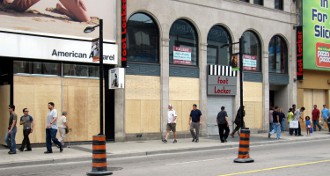 As retailers moved to ditch pricey high street property and weather the storm somewhere cheaper, many town centres started resembling recession ghost towns, but not for long. According to the latest figures from the Local Data Company, the overall store vacancy rate fell to 14.1 percent, from 14.2 percent in February.
As retailers moved to ditch pricey high street property and weather the storm somewhere cheaper, many town centres started resembling recession ghost towns, but not for long. According to the latest figures from the Local Data Company, the overall store vacancy rate fell to 14.1 percent, from 14.2 percent in February.
Tag: property
Shop rents in Cardiff tumble 70 percent
 The high street is hurting and property owners in Wales seem to be getting the worst of it. According to property experts and the council, the number of empty shops in Cardiff increased from 9.7 percent in October 2008 to 15.8 percent last October.
The high street is hurting and property owners in Wales seem to be getting the worst of it. According to property experts and the council, the number of empty shops in Cardiff increased from 9.7 percent in October 2008 to 15.8 percent last October.
As a result, shop rents have dropped by up to 70 percent in parts of Cardiff’s historic city centre, reports Wales Online. The depressing figures were presented to Cardiff council planners by property firm Calan Retail, which is struggling to find tenants for its own property.
Calan has now applied for permission to change the use for the ground floor and upper floors in its Habitat building to restaurants and cafes, as they should do better than retail shops. Calan executive Andy Sturrock told the council that the retail market went through a seismic change over the past six years.
Rents on Queen Street have fallen by a third since 2008, but the worst example comes from a unit at Cardiff’s Capitol Center. The unit used to be rented by fashion chain Oasis for £224,000 per annum, but last year it was acquired by a sandwich shop for £70,000.
European retail property market stays busy
 Although Europe is going through the worst economic crisis in decades, the retail property market is still showing signs of life – and it’s getting better. It is estimated that €16.3 billion of retail property was traded in the first six months of the year, up 31 percent compared to the first half of 2012.
Although Europe is going through the worst economic crisis in decades, the retail property market is still showing signs of life – and it’s getting better. It is estimated that €16.3 billion of retail property was traded in the first six months of the year, up 31 percent compared to the first half of 2012.
Demand is strong and it’s coming from various sectors, with increased spending on cross-border deals. There is a lot more interest from institutional investors, including Asian funds. The focus appears to be on the more traditional shopping centre market rather than out of town locations.
Britain remains Europe’s biggest retail investment market, with an impressive market share of 32 percent. Volumes are up 94 percent over the first six months of 2012, reports Property Magazine. Other big markets are also doing well, especially in Northern Europe. Germany, Sweden, Norway, Denmark and France have all experienced a rally. Oddly enough, there is more interest in troubled markets like Greece, Portugal, Italy, Spain and Ireland. The temptation of low prices and volatility seems to be attracting risk loving investors with nerves of steel.
Michael Rodda, head of EMEA Retail Investment at Cushman & Wakefield, said some investors are starting to look further afield, while others are contemplating taking on more risk, usually via development.
“The Nordics were strong again in H1 and we expect this to continue into the second half of the year but we are beginning to see increased activity outside such core markets,” he said. There have been some notable transactions in Central and Eastern Europe for example, such as Atrium’s acquisition of Galeria Dominikanska in Poland, and there is also now real momentum building up in Iberia, where we expect to see a surge in activity as rental re-pricing looks to have bottomed out and improving availability of finance appears to be on the horizon.”
David Hutchings, Head of EMEA Research at Cushman & Wakefield, said retail property remains in demand across Europe and buyers seem undeterred by the stresses and strains of the market, and the increasing competition from online retailers.
Hutchings believes supply levels are likely to improve toward the end of the year, and investment in the retail sector is expected to increase 8 percent on 2012.
Tesco profits flag
 Tesco is facing the same fate as many other businesses, reporting the first annual profit loss in nearly 20 years.
Tesco is facing the same fate as many other businesses, reporting the first annual profit loss in nearly 20 years.
The supermarket giant said pre-tax profits were down 51 percent to £1.96 billion, while post-tax profits including the cost of its £1.2 billion US exit were £120 million, marking a decrease of 95.7 percent.
The company confirmed that it would be backing out of the US after its investment in 190 Fresh and Easy stores failed to make it a profit.
In Blighty the company has also announced a property write down of £804 million. This was as a result of a review by the company, which uncovered more than 100 sites, scooped up five years ago for potential stores, now lying dormant.
In a blog post, head honcho Philip Clarke said: “Much of this property was bought more than five years ago, some more than 10 years ago.
“That is before the 2008 financial crisis, before the iPhone, social media, tablet computers, before we knew how profoundly technology would change both how we and our customers live and shop.
“Technology has changed much that we all took for granted and it is still changing. The last five years have shown that change in retail can be disruptive and come in sharp steps, not a steady trend. We must anticipate change and act decisively so we looked hard at the land we own and conclude that although we have a strong and attractive network of stores, we will never develop some of this land, mostly the very large mixed-use developments.”
The past three months have also not been favourable to the company, with Tesco claiming its sales, not including petrol, only rose by 0.5 percent. This was a decrease from the growth the company faced in six weeks to 5 January when the company marked a 1.8 percent rise as a result of Christmas shopping.





